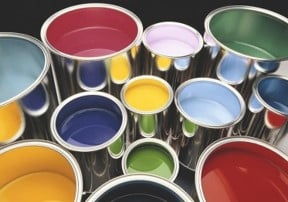Cationic UV curing is a process in which cationic resin molecules undergo polymerization and cross-linking when exposed to ultraviolet (UV) light. At the core of this process is the use of cationic photoinitiators, which generate reactive species under UV light, triggering a chain reaction that hardens the coating.

Unlike traditional solvent-based curing, cationic UV curing does not rely on volatile organic solvents. It is extremely fast, energy-efficient, and environmentally friendly—producing virtually no VOC emissions. These characteristics make it especially suitable for high-speed manufacturing environments seeking sustainable solutions.
Cationic UV coating refers to a type of coating product that utilizes cationic UV curing as its hardening mechanism. These coatings are formulated with cationic resins and specialized photoinitiators, allowing them to rapidly solidify into durable protective layers upon exposure to UV light.

Commonly used on substrates such as wood, metal, plastic, paper, and electronics, cationic UV coatings are known for their superior chemical resistance, scratch resistance, and UV stability. In many formulations, cationic epoxy systems play a crucial role in achieving these performance characteristics. Applications range from furniture finishing and automotive parts to electronic components, offering enhanced durability, visual appeal, and fast throughput.

| Aspect | Cationic UV Curing | Cationic UV Coating |
|---|---|---|
| Definition | A photoinitiated polymerization process that uses UV light to harden cationic resins | A coating system that employs cationic UV curing to form protective films |
| Technical Dependency | Provides the underlying curing mechanism | Requires cationic UV curing for activation and hardening |
| Environmental Benefit | Solvent-free, low VOC, energy-efficient | Leverages curing to deliver eco-friendly, efficient coatings |
| Industrial Role | Enables high-speed, green manufacturing | Offers high-performance surface protection across industries |
These two are inherently interconnected: without cationic UV curing, cationic UV coatings cannot function. Conversely, choosing a specific cationic UV coating implies using a compatible curing process. In many cases, specialty epoxy resins are incorporated into the formulation to enhance the coating’s performance, offering superior chemical resistance and durability. Their synergy with cationic UV curing is critical for consistent, fast, and eco-friendly results in UV-based coating systems.
Cationic UV coating systems have become increasingly prevalent in sectors that demand both performance and sustainability. Key applications include:

Furniture finishing: Fast-drying, scratch-resistant wood coatings
Automotive components: Durable, corrosion-resistant protective films
Electronics: Precision coatings for circuit boards and housings
Packaging and labels: High-gloss, abrasion-resistant finishes
Thanks to their rapid cure times and environmental advantages, cationic UV systems help manufacturers reduce energy consumption, increase production throughput, and meet stricter environmental regulations—all without sacrificing performance. Working with a trusted aliphatic epoxy supplier ensures access to high-quality, sustainable resin solutions that enhance the performance of these systems while maintaining eco-friendly standards. If you want get cationic UV curing epoxy, Tetrawill is your best choice!